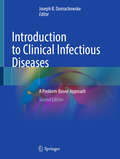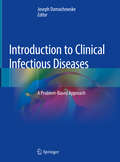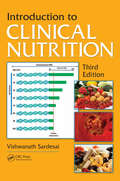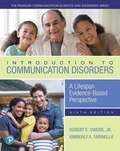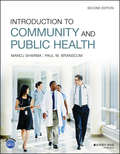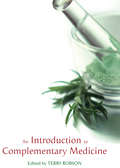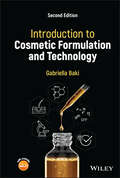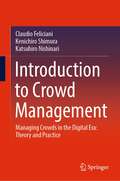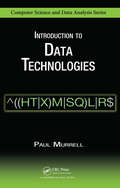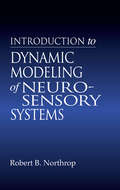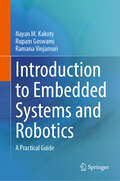- Table View
- List View
Introduction to Clinical Ethics: Perspectives from a Physician Bioethicist
by Saleem ToroThis textbook offers an introduction to the field of bioethics, specifically from a practicing physician standpoint. It engages a wide range of recent scholarship and emerging research covering many crucial topics in clinical ethics. While there has been increasing attention to the role of bioethics in medicine, the gap between theory and practice still exists, and it continues to impede the dialogue between health care professionals from one side and bioethicists and philosophers of medicine from the other side. This book builds bridges and open channels of connection between different parties in these conversations. It does so from a physician’s practical perspective, engaging recent scholarship and emerging research, to shed light on pivotal ethical dilemmas in contemporary clinical practice.
Introduction to Clinical Infectious Diseases: A Problem-Based Approach
by Joseph B. DomachowskeThe field of infectious diseases drifts and shifts as new pathogens emerge or re-emerge, new treatment modalities become available, and new prevention strategies are implemented. Students of medicine and the clinically experienced teachers who help to steer their education will benefit from Clinical Infectious Diseases: A Problem-Based Approach because each chapter first defines a clinical diagnosis and moves to descriptions of common and/or classic causes of the problem while including tables, lists and descriptions of the rare and unusual etiologies we all find so fascinating. General management approaches are included to help build foundations of clinical care of infections including, but not limited to the administration of antibiotics. Reminders of classic complications seen with specific infections and/or their treatment are used to emphasize the importance of ongoing vigilance even after a specific microbiologic diagnosis has been identified. Common causes of each problem are emphasized. Unusual and rare causes are mentioned briefly with clinical clues about when to consider them. Case descriptions are used to support, facilitate, and refine the learner’s deductive clinical reasoning skills. The book is written for a broad audience of medical trainees by a diverse group of medical experts, then edited by an infectious disease physician-scientist-educator to maintain a primary focus on the infection aspects of each problem. Basic content is reviewed first, then layered with advancing complexity. Call-out boxes are used to emphasize key concepts while figures and tables provide insights into more complex, rare but important and/or classic features of infection. As such, the book will appeal to a broad range of students and trainees from those just entering the health care field to those who have already reached subspecialty training.
Introduction to Clinical Infectious Diseases: A Problem-based Approach
by Joseph DomachowskeInfectious diseases as a specialty suffers from many unique challenges stemming from lower salaries compared to other medical specialties and difficulty keeping the younger demographic within the field. With emerging infections, new diagnostic and research tools, and changing migration patterns, these problems are amplified; infectious disease specialists are in higher demand than ever with fewer and fewer specialists available to support patients and colleagues outside of the field. To meet these increasing challenges, it is vital for the workforce of the future to have the best training possible. This book aims to provide this support. <P><P> As trainees, all physicians face clinical infectious disease scenarios on a daily basis. They receive basic training in common infections, giving them the tools needed for initial diagnostic studies and empiric treatment. This approach, however, still leaves them struggling with nuances of treating common infections, infections that masquerade as other diseases, rare infection, advanced diagnostics, complicating medical conditions, and a wide range of medical complexities. Important clinical microbiology details and host susceptibility risks will be highlighted when discussing uncommon infections. <P><P> Each chapter begins by defining a distinct clinical infectious disease problem and the most common cause(s). The next section of each chapter identifies the key questions to consider, including other possible pathogens, medical history, alternate microbiologic diagnoses, instances of unexpected result. This book is the only academic text designed specifically to meet this challenge by targeting learners at all levels. To do this, the text incorporate 30-40 common clinical infectious disease scenarios in both adult and pediatric hosts. It includes easy-to-access “tips and tricks” for when to look further or consider possibilities that are unusual that is useful for someone who is new to the information or has limited experience within infectious diseases. The text heavily features teaching and learning tools, including call out boxes that prioritizes infectious etiologies, host risk factors, important microbiologic clues, and important clinical history clues. The text also includes review questions and quiz-like challenges to reinforce the concepts. <P><P> Written by experts in the field Clinical Infectious Diseases is the most cutting-edge academic resource for all medical students, fellows, residents, and trainees, including infectious disease specialists in both adult and pediatric care, internal medicine specialists, and hospitalists.
Introduction to Clinical Methods In Communication Disorders Third Edition
by Rhea PaulThe bestselling core textbook on communication disorders is better than ever with this new third edition, thoroughly revised and based on updated ASHA standards. Covering a broad range of disorders and developmental levels, this text gives future professionals up-to-date guidance on evidence-based practice from more than 20 academics and working clinicians. Preservice SLPs and audiologists will get a comprehensive guide to contemporary clinical practice--one they will use for the rest of their careers to provide the best possible services for people with communication disorders. An essential text for all students in clinical methods courses and a reliable reference for practicing professionals!
Introduction to Clinical Nutrition
by Vishwanath SardesaiDietary factors have been implicated in at least four of the ten leading causes of death in the U.S. (heart disease, cancer, diabetes, and stroke). Nevertheless, physicians frequently receive inadequate training in nutrition to properly counsel their patients. Introduction to Clinical Nutrition, Third Edition discusses the physiologic and metabolic
Introduction to Cognitive Ethnography and Systematic Field Work (Qualitative Research Methods)
by G. Mark SchoepfleIntroduction to Cognitive Ethnography and Systematic Field Work by G. Mark Schoepfle provides a guide to the fundamentals of cognitive ethnography for qualitative research. A focus of this technique is collecting data from flexible but rigorous interviews. These interviews are flexible because they are designed to be structured around the semantic knowledge being elicited from the speaker, not around some pre-conceived design that is based on the researcher’s background, and they are rigorous because the basic linguistic and semantic structures are shared among all cultures. Written by one of the founders of this technique, this text provides a wealth of concentrated knowledge developed over years to best suit this collaborative and participant-centric research process. Eight chapters show how intertwined data collection and analysis are in this method. The first chapter offers a brief history and overview of the cognitive ethnography. Chapter 2 covers planning a research project, from developing a research question to ethics and IRB requirements. The next two chapters cover interview background, techniques, and structures. Chapter 5 addresses analysis while Chapter 6 covers transcription and translation. Chapter 7 covers observation, while a final chapter address writing a report for both consultants and outside audiences.
Introduction to Cognitive Ethnography and Systematic Field Work (Qualitative Research Methods)
by G. Mark SchoepfleIntroduction to Cognitive Ethnography and Systematic Field Work by G. Mark Schoepfle provides a guide to the fundamentals of cognitive ethnography for qualitative research. A focus of this technique is collecting data from flexible but rigorous interviews. These interviews are flexible because they are designed to be structured around the semantic knowledge being elicited from the speaker, not around some pre-conceived design that is based on the researcher’s background, and they are rigorous because the basic linguistic and semantic structures are shared among all cultures. Written by one of the founders of this technique, this text provides a wealth of concentrated knowledge developed over years to best suit this collaborative and participant-centric research process. Eight chapters show how intertwined data collection and analysis are in this method. The first chapter offers a brief history and overview of the cognitive ethnography. Chapter 2 covers planning a research project, from developing a research question to ethics and IRB requirements. The next two chapters cover interview background, techniques, and structures. Chapter 5 addresses analysis while Chapter 6 covers transcription and translation. Chapter 7 covers observation, while a final chapter address writing a report for both consultants and outside audiences.
Introduction to Communication Disorders: A Lifespan Evidence-Based Perspective
by Robert E. Owens Dale Evan Metz Kimberly A. FarinellaA clear, comprehensive introduction to communication sciences and disorders Introduction to Communication Disorders: A Lifespan Evidence-Based Perspective presents recent advances in the assessment and treatment of communication disorders in a highly readable manner. Each chapter is concise, yet comprehensive-striking a just right balance of information appropriate for introductory-level students. Readers gain a basic foundation in the areas of anatomy and physiology of speech and hearing, and an overview of the various disorders that affect voice, fluency, articulation, language, cognition, swallowing, and hearing across the lifespan. Updated case studies, evidence-based practice summary boxes, and new medically based photographs help students bridge the gap between theory and clinical application.
Introduction to Communicative Disorders (4th edition)
by M. N. HegdeIn this update of the 2001, 1995, and 1991 editions, Hegde (communication sciences and disorders, California State U. , Fresno) introduces the rapidly growing science of communication and profession of communicative disorders. Coverage includes a new chapter on literacy skills in children and the role of the speech-language pathologist in literacy intervention; profiles of speech-language pathologists and audiologists; and expanded material on audiology, audiology rehabilitation, and disorders of swallowing. The text includes study questions; information on professional education, organizations, and standards; a glossary.
Introduction to Community and Public Health
by Manoj Sharma Paul W. Branscum Ashutosh AtriLearn the basics of the five core areas of community and public health Introduction to Community and Public Health covers the basics in each area of community and public health as identified by the Association of Schools of Public Health. In a student-friendly approach, authors Manoj Sharma, Paul W. Branscum, and Ashutosh Atri discuss epidemiology, biostatistics, social and behavioral sciences, environmental health, and healthy policy and management. Written to serve both graduate and undergraduate public health students, as well as to help prepare for the Certified in Public Health (CPH) exam, Certified Health Education Specialist (CHES) exam and Master certified in Health Education Specialist (MCHES) exam, the book covers each of these five core disciplines, plus other important topics such as: Population dynamics and control Air, water, and noise pollution, and other environmental issues Program planning, budgeting, management, and evaluation Systems thinking and leadership in community and public health Students will gain insight into the descriptive, inferential, and analytical aspects of community and public health, as well as models, methods, and theories in health education and health promotion. Introduction to Community and Public Health provides the foundation necessary to build the skills of tomorrow's community and public health leaders.
Introduction to Community and Public Health
by Manoj Sharma Paul W. BranscumLearn the basics of the five core areas of community and public health Introduction to Community and Public Health, 2nd Edition covers the basics in each area of community and public health as identified by the Association of Schools of Public Health. With a student-friendly approach, the authors discuss epidemiology, biostatistics, social and behavioral sciences, environmental health, and healthy policy and management. The book is written to serve both graduate and undergraduate public health students, as well as to help prepare for the Certified in Public Health (CPH) exam, Certified Health Education Specialist (CHES) exam and Master certified in Health Education Specialist (MCHES) exam, the book covers each of these five core disciplines, plus other important topics.
Introduction to Complementary Medicine
by Terry Robson* What is complementary medicine?* What evidence is there to support its use?* What can orthodox medicine learn from holistic practices? Providing a sound introduction to the range of treatments and philosophies usually termed 'complementary and alternative medicine', this book offers a systematic explanation of the philosophies and practices that underpin contemporary complementary medicine.Introduction to Complementary Medicine examines the rise in popularity of complementary medicine and discusses the challenges of developing a more integrated system of health care. Drawing on recent research, this book explores the development, application, evidence, contraindications and appropriateness of a wide range of traditional systems of medicine and healing modalities, including Herbal Medicine, Massage, Osteopathy, Traditional Chinese Medicine, Aromatherapy, Chiropractic, Ayurveda, Yoga and Meditation.Written by leading academics, researchers and experienced practitioners, Introduction to Complementary Medicine is designed to be used as a reference for students and practitioners in a range of health professions.With a foreword by Dr Joseph Pizzorno ND
Introduction to Complexity and Complex Systems
by Robert B. NorthropThe boundaries between simple and complicated, and complicated and complex system designations are fuzzy and debatable, even using quantitative measures of complexity. However, if you are a biomedical engineer, a biologist, physiologist, economist, politician, stock market speculator, or politician, you have encountered complex systems. Furthermore
Introduction to Computational Health Informatics (Chapman & Hall/CRC Data Mining and Knowledge Discovery Series)
by Arvind Kumar Bansal Javed Iqbal Khan S. Kaisar AlamThis class-tested textbook is designed for a semester-long graduate or senior undergraduate course on Computational Health Informatics. The focus of the book is on computational techniques that are widely used in health data analysis and health informatics and it integrates computer science and clinical perspectives. This book prepares computer science students for careers in computational health informatics and medical data analysis. Features Integrates computer science and clinical perspectives Describes various statistical and artificial intelligence techniques, including machine learning techniques such as clustering of temporal data, regression analysis, neural networks, HMM, decision trees, SVM, and data mining, all of which are techniques used widely used in health-data analysis Describes computational techniques such as multidimensional and multimedia data representation and retrieval, ontology, patient-data deidentification, temporal data analysis, heterogeneous databases, medical image analysis and transmission, biosignal analysis, pervasive healthcare, automated text-analysis, health-vocabulary knowledgebases and medical information-exchange Includes bioinformatics and pharmacokinetics techniques and their applications to vaccine and drug development
Introduction to Computer Systems for Health Information Technology (Second Edition)
by Nanette B. Sayles Kathy C. TrawickThe objectives of this book are: Describe the functions of the basic components of the personal computer to include hardware, software, networks, and Internet technologies; Identify and discuss the impact of computers in healthcare in all areas within a facility; Discuss the history of computers in healthcare; Compare and contrast the similarities and differences between the Internet, intranet, and extranet as used in healthcare.
Introduction to Cosmetic Formulation and Technology
by Gabriella Baki Kenneth S. AlexanderDesigned as an educational and training text, this book provides a clear and easily understandable review of cosmetics and over the counter (OTC) drug-cosmetic products. The text features learning objectives, key concepts, and key terms at the beginning and review questions and glossary of terms at the end of each chapter section. * Overviews functions, product design, formulation and development, and quality control of cosmetic ingredients * Discusses physiological, pharmaceutical, and formulation knowledge of decorative care products * Reviews basic terms and definitions used in the cosmetic industry and provides an overview of the regulatory environment in the US * Includes learning objectives, key concepts, and key terms at the beginning and review questions and glossary of terms at the end of each chapter section * Has PowerPoint slides as ancillaries, downloadable from the book's wiley.com page, for adopting professors
Introduction to Cosmetic Formulation and Technology
by Gabriella BakiIntroduction to Cosmetic Formulation and Technology An accessible and practical review of cosmetics and OTC drug-cosmetic products In the newly revised second edition of Introduction to Cosmetic Formulation and Technology, veteran educator and researcher Dr. Gabriella Baki delivers a comprehensive discussion of cosmetics and personal care products, including coverage of basic concepts, ingredient selection, formulation technology, and testing. The book offers a clear and easy-to-understand review of cosmetics and over the counter (OTC) drug-cosmetic products available in the United States. In this latest edition, the author expands on general concepts and adds brand-new chapters on the basics of cosmetics testing, ingredients, and skin lightening products. Each chapter includes a summary of common abbreviations with questions provided online, alongside a solutions manual for instructors. Readers will also find: A thorough introduction to the basic definitions, claims, and classifications of cosmetics and OTC drug-cosmetic products Comprehensive explorations of the current rules and regulations for cosmetics and OTC drug-cosmetic products in the United States and European Union Detailed review of cosmetic ingredients, functions, and typical uses both in a dedicated a chapter and included within various others Practical coverage of good manufacturing practices for cosmetics, including documentation, buildings and facilities, equipment, and personnel Fulsome review of a variety of skin and hair care products, color cosmetics, and other personal care products Perfect for undergraduate and graduate students studying cosmetic science in chemistry, chemical engineering, pharmaceutical, biomedical, and biology departments, Introduction to Cosmetic Formulation and Technology will also benefit cosmetic chemists, cosmetic product formulators, cosmetic scientists, quality control managers, cosmetic testing specialists, and technicians.
Introduction to Crowd Management: Managing Crowds in the Digital Era: Theory and Practice
by Katsuhiro Nishinari Claudio Feliciani Kenichiro ShimuraThis book will guide you in a simple and illustrative way through all aspects related to crowd behaviour, including sociological theories, methods of crowd control, people detection and tracking, and crowd simulation and prediction, while examining previous accidents to learn from the past. Crowds are a constant presence in most cities around the globe and mass gatherings are attracting an increasing number of people. While experience can help manage large crowds and plan mass events, knowledge on crowd behaviour is fundamental for successfully dealing with unexpected situations, improving current practices and implementing state-of-the-art technologies in management strategies. After letting people laugh about the controversy on colliding pedestrians, with this book, two of the Ig Nobel laureates on pedestrian traffic will make you think (and learn) presenting through a collaborative approach, combining theoretical with practical advice, the science behind crowd dynamics and the importance it plays in our increasingly urbanized society. Fundamental aspects related to crowd management are presented using simple concepts requiring little or no knowledge of mathematics or engineering. Professionals involved in pedestrian traffic, as well as students and researchers entering the field of crowd dynamics, will find this book a useful interdisciplinary introduction on the subject, exploring both fundamental background information and more specific topics related to crowd management.
Introduction to Data Science in Biostatistics: Using R, the Tidyverse Ecosystem, and APIs
by Thomas W. MacFarlandIntroduction to Data Science in Biostatistics: Using R, the Tidyverse Ecosystem, and APIs defines and explores the term "data science" and discusses the many professional skills and competencies affiliated with the industry. With data science being a leading indicator of interest in STEM fields, the text also investigates this ongoing growth of demand in these spaces, with the goal of providing readers who are entering the professional world with foundational knowledge of required skills, job trends, and salary expectations. The text provides a historical overview of computing and the field's progression to R as it exists today, including the multitude of packages and functions associated with both Base R and the tidyverse ecosystem. Readers will learn how to use R to work with real data, as well as how to communicate results to external stakeholders. A distinguishing feature of this text is its emphasis on the emerging use of APIs to obtain data.
Introduction to Data Technologies (Chapman & Hall/CRC Computer Science & Data Analysis)
by Paul MurrellProviding key information on how to work with research data, Introduction to Data Technologies presents ideas and techniques for performing critical, behind-the-scenes tasks that take up so much time and effort yet typically receive little attention in formal education. With a focus on computational tools, the book shows readers how to improve thei
Introduction to Deep Learning for Healthcare
by Cao Xiao Jimeng SunThis textbook presents deep learning models and their healthcare applications. It focuses on rich health data and deep learning models that can effectively model health data. Healthcare data: Among all healthcare technologies, electronic health records (EHRs) had vast adoption and a significant impact on healthcare delivery in recent years. One crucial benefit of EHRs is to capture all the patient encounters with rich multi-modality data. Healthcare data include both structured and unstructured information. Structured data include various medical codes for diagnoses and procedures, lab results, and medication information. Unstructured data contain 1) clinical notes as text, 2) medical imaging data such as X-rays, echocardiogram, and magnetic resonance imaging (MRI), and 3) time-series data such as the electrocardiogram (ECG) and electroencephalogram (EEG). Beyond the data collected during clinical visits, patient self-generated/reported data start to grow thanks to wearable sensors’ increasing use. The authors present deep learning case studies on all data described.Deep learning models: Neural network models are a class of machine learning methods with a long history. Deep learning models are neural networks of many layers, which can extract multiple levels of features from raw data. Deep learning applied to healthcare is a natural and promising direction with many initial successes. The authors cover deep neural networks, convolutional neural networks, recurrent neural networks, embedding methods, autoencoders, attention models, graph neural networks, memory networks, and generative models. It’s presented with concrete healthcare case studies such as clinical predictive modeling, readmission prediction, phenotyping, x-ray classification, ECG diagnosis, sleep monitoring, automatic diagnosis coding from clinical notes, automatic deidentification, medication recommendation, drug discovery (drug property prediction and molecule generation), and clinical trial matching.This textbook targets graduate-level students focused on deep learning methods and their healthcare applications. It can be used for the concepts of deep learning and its applications as well. Researchers working in this field will also find this book to be extremely useful and valuable for their research.
Introduction to Diagnostic Microbiology for the Laboratory Sciences
by Maria Dannessa DelostIntroduction to Diagnostic Microbiology for the Laboratory Sciences, Second Edition provides a foundation in microbiology that is essential for a career as a medical laboratory technologist/technician (MLT). A key text for students and a helpful reference for practitioners, it reviews the microorganisms most commonly encountered in clinical settings and clearly explains basic laboratory procedures.This text provides a concise overview of topics and facilitates comprehension with learning objectives, key terms, case studies, and review questions. In addition, the text includes laboratory exercises available as printable and writable PDFs in Navigate Advantage, eliminating the need for a separate laboratory manual. Covering content required in the MLT curriculum and featured on the ASCP certification exam, this accessible text will help prepare students for a career in laboratory science.Introduction to Diagnostic Microbiology for the Laboratory Sciences is on the recommended reading list to prepare for the ASCP MLT exam. (American Society for Clinical Pathology, Medical Laboratory Technician exam). NEW! Case Studies and What Would You Do Next features have been added to most chapters to guide students through scenarios in a microbiology laboratory.NEW! An appendix has been added that presents information on emerging topics of microbiology, including biofilms, antibiotic resistance, zoonosis, healthcare associated infections, and bioterrorism.NEW! Here and Now sections present an overview and updatedate of a current microbiology topic or issue.Each chapter has learning objectives and review questions that correlate with the ASCP MLT/MLS certification examinations.Laboratory exercises correlate with the didactic material can be found as separate electronic printable and writable documents in Navigate Advantage. Diagnostic Mircobiology Medical Microbiology Clinical Microbiology Parasitology Microbiology Clinical Diagnostic Microbiology © 2022 | 600 pages
Introduction to Dynamic Modeling of Neuro-Sensory Systems (Biomedical Engineering)
by Robert B. NorthropAlthough neural modeling has a long history, most of the texts available on the subject are quite limited in scope, dealing primarily with the simulation of large-scale biological neural networks applicable to describing brain function. Introduction to Dynamic Modeling of Neuro-Sensory Systems presents the mathematical tools and methods that can de
Introduction to Economic Evaluation in Oral Health Care
by Carlos Zaror Rodrigo MariñoThis is the first known book on economic evaluations specifically geared to oral health professionals. The book serves as a starting point that explains the concepts and tools required for practitioners with little or no formal training or experience in economic evaluation to conduct such evaluations in oral health(care). It provides the foundation for applying economic evaluation principles to oral health programs as well as more advanced technical information for those interested in acquiring knowledge of health economics within the context of oral health care.In the book, the authors describe the different types of economic evaluation and discuss their role and application in oral health care. Topics explored among the chapters include:Why carry out an economic evaluation in oral health care?Aspects of decision modelling for economic evaluation in oral health careInterpreting economic evaluation in oral healthWorked examples in cost-effectiveness, cost-benefit, and cost-utility analysesAssessing the quality and usefulness of economic evaluation in oral health: a practical approach for cliniciansUsing economic evaluations to inform decision-making in oral health: TransferabilityEconomic evaluation: uses and potential uses in oral health policy developmentIntroduction to Economic Evaluation in Oral Health Care has an applied orientation that emphasizes practical solutions to managing existing problems and situations in oral health care. As such, the book is essential reading for oral health professionals including dentists, oral health therapists, and dental hygienists, as well as students in the oral health professions. The text is also an appropriate and useful resource for other health practitioners and managers who are interested in enhancing their practical understanding of economic evaluation including health economists and other health professionals and decision-makers.
Introduction to Embedded Systems and Robotics: A Practical Guide
by Ramana Vinjamuri Rupam Goswami Nayan M. KakotyThis book is a technical guide to fundamentals of embedded systems and robotics, and their application to practical problems. The book hosts the concepts of different elements related to the amalgamation of embedded system and robotics before tackling the physics of robotic systems.This book is the ABC of embedded system and robotics: A for acquiring the concepts, B for building robotic systems, and C for creating solutions. It is appropriate for undergraduate and post-graduate students of electronics and electrical engineering, robotics engineering, computer science and engineering, mechanical engineering, and allied disciplines. Specifically, it will act as a guide for students doing robotics projects in their final semesters.

